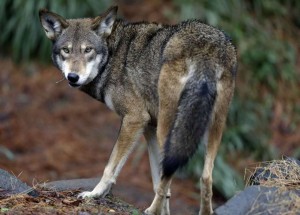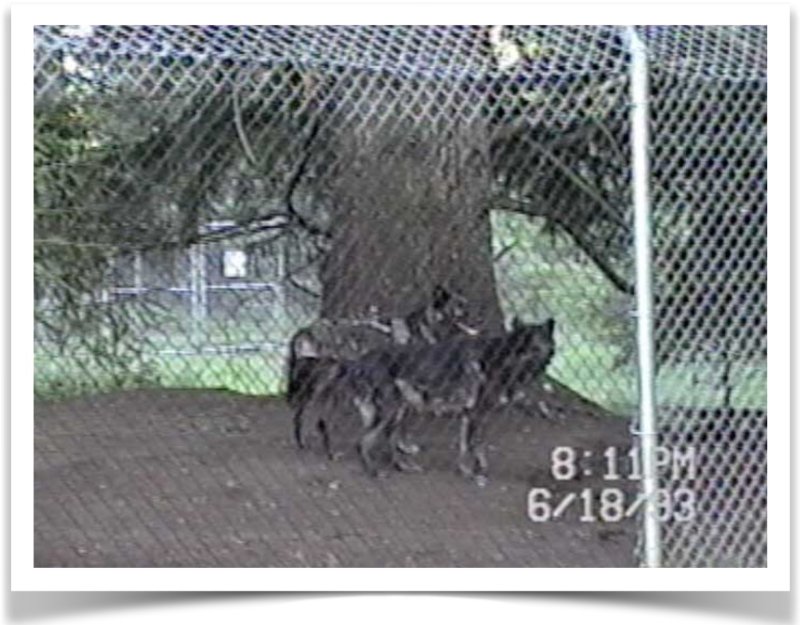
Imagine for a moment you are in a situation where escape is impossible. Not those occasional bad days when life problems summate and produce a feeling of no way out. Instead, envision a more active process, one in which you begin to understand that the inevitable catastrophic consequences are unavoidable. You try plan A, then B, and C. Finally, you realize nothing will work. Then the assault begins. If you survive, there may be a psychological price to pay, one that could last a lifetime.
This is what happened to the wolf I studied who was taken from the wild and placed into captivity. Her name was Tenino, apparently named after the town where Wolf Haven International was located. Wolf Haven was a sanctuary near Olympia, WA, that housed wolves that had been taken from misguided people who attempted to raise them as pets, or were removed from breeders who used them to produce hybrid wolf-dogs. Tenino was the only wolf from the wild.
She had come from the Ninemile pack in western Montana. In 1990, the original six pups were born, one of which was Tenino. They were often observed by nearby ranchers who took video of them playing on tree stumps in the forest (as seen in the picture above). By the age of three months, their mother’s radio collar was found cut and thrown into the Ninemile River. Presumably she had been shot. This left the father, the alpha male, with many mouths to feed. By then he was also radio collared and U. S. Fish and Wildlife Service biologists were able to monitor his approximate whereabouts.
The Ninemile Valley was located about twenty-five miles northwest of Missoula and next to Interstate 90. On the other side of the interstate was a population of elk, and the alpha male crossed the highway on a regular basis to hunt this area. One evening, when the pups were six months of age, the male left for his usual hunting grounds. He never returned. His body was found on I-90, having been hit by a vehicle.
The pups were now alone, not yet old enough to fully understand what was on the menu or how to catch it. Until the pups could hunt on their own, biologists laid out road-killed deer for them to eat and hoped they would not learn to kill the domesticated livestock that lived in the area. At almost a year old, several of the pups, including Tenino, crossed over the mountains to a nearby ranch and apparently killed two yearling steers. U. S. Fish and Wildlife Service biologists used a helicopter to capture most of the pups. The chopper hovered above the tree tops, scaring the wolves out into the open; the biologists then swooped down and shot them with tranquilizing darts. Tenino and two other pups were placed in a kennel for several days and fitted with radio collars. They were transported to Glacier National Park in northwest Montana and released. For about a week, they stayed together then went their separate ways. Two of the pups were eventually shot by ranchers. Tenino, however, crossed over the Continental Divide into eastern Montana. She was found near the town of Dupuyer by agency biologists, where she had killed two sheep.
Management policy at the time stated that any wolf found to have killed livestock would be relocated somewhere else. If the wolf repeated the offense, it was to be killed. Tenino’s time was up. Because of her young age, however, biologists thought she might adapt to a captive life. Once again, she was chased down with a helicopter and shot with tranquilizers. Wolf Haven was contacted and a deal was made. Instead of death, Tenino’s sentence was commuted to life in prison, and she arrived at her new home in June 1991. Three weeks later she was joined by another recruit, Joe, and they remained enclosure mates for the remainder of their lives. Eleven months after their arrival, I began my study.
Effects of Capture
All animals, including humans, live in their own specific world and respond to the environment based on their physiology, anatomy, perceptual abilities and past experience. This is referred to as the animal’s Umwelt. Capturing them in the wild disrupts or destroys their previous Umwelt, and the animals must construct a new, subjective world based on their captive conditions. Success would be contingent on not only the animal’s adaptability but also on their access to the tools needed for building a new Umwelt, such as proper housing, adequate space, food and low stress. Other than food, Tenino received none of the other requirements, especially low stress.
Removing animals from the wild can cause them extreme psychological stress which often is more detrimental than physical trauma. The study revealed that Tenino suffered from post-traumatic stress disorder (PTSD), usually caused by factors that are uncontrollable and unpredictable. It began at the moment of capture. Like an alien abductee, Tenino didn’t know what kind of machine was chasing her, who was in it, or their intentions. And it happened twice. At Wolf Haven she displayed a range of classic PTSD behavior that included hypervigilance (extreme attentiveness), sleep problems, exaggerated startles (overreactions to sudden sounds or actions), avoidance of activities (especially human-oriented) and in her case looking up at aircraft. Unfortunately, captivity only perpetuated these symptoms.
Although the enclosure that housed Joe and Tenino was not viewed by the general public, it was still akin to a fish bowl from Tenino’s perspective.
The keepers approached from all sides as did the food truck. She ran from all of them while the captive-born wolves approached, knowing food was coming. Air traffic from nearby Fort Lewis and Olympia Airport, along with jet liners from SeaTac airport, regularly flew over the enclosure. Tenino would look up with ears back and body crouched and track the planes across the sky.  No other wolf did that. Loud gunshots occasionally rang out next to the enclosure from the neighboring farmer’s property, along with thunderous “booms” from the nearby bombing range at Fort Lewis. Even the crowds from Wolf Haven’s weekend Howl-ins increased Tenino’s hypervigilance and avoidance, but there was nowhere to go. There was some good news, however. Because wolves are social creatures, I made my activities as predicable as possible – opposite of the keepers. Eventually my presence calmed her down, and her anxiety increased when I left. I was the only human, in her mind, that had not tried to cause her harm, and I had become a calming influence.
No other wolf did that. Loud gunshots occasionally rang out next to the enclosure from the neighboring farmer’s property, along with thunderous “booms” from the nearby bombing range at Fort Lewis. Even the crowds from Wolf Haven’s weekend Howl-ins increased Tenino’s hypervigilance and avoidance, but there was nowhere to go. There was some good news, however. Because wolves are social creatures, I made my activities as predicable as possible – opposite of the keepers. Eventually my presence calmed her down, and her anxiety increased when I left. I was the only human, in her mind, that had not tried to cause her harm, and I had become a calming influence.
Lessons Learned
The data I had collected during the study raised moral and ethical issues regarding animal welfare and husbandry, which made the board of trustees at Wolf Haven feel uncomfortable. For the duration of our study, they struggled to decide what should be the best course of action regarding Tenino’s welfare. The opinions ranged from euthanizing Tenino to abolishing our study. They chose the latter and ended the study after several years. The arguing and the mix of everyone’s morals and ethics delayed, at the time, what little could have been done for Tenino. Consequently, her surroundings, as well as the existence of the stressors that perpetuated her PTSD, remained virtually the same.
Seven years later, a former student sent me a page from Wolf Haven’s most recent newsletter which announced the death of Tenino. She had died at the age of almost eleven. Most captive wolves, at least at Wolf Haven, lived fifteen or sixteen years. Few died at Tenino’s age. The picture in the article showed an old, beleaguered wolf which I found shocking. I remembered her when she had been years younger, trotting around the enclosure looking up at aircraft and attempting to hide when the keepers approached. Perhaps this explained the picture I saw and her early death, or maybe she had died younger for other reasons. However, the article explained she had died of sinus cancer, an unusual disease. It accounts for only 1 percent of tumors found in domestic dogs. This indicated to me the stress levels I had measured during my study had an impact as she aged. Her immune system must have become greatly compromised for her to acquire such a strange form of cancer.
People are often captives of their own Umwelts and are unable to envision the capacity or capability of others. Apparently, it was Tenino’s misfortune not to have been born human. She was looked upon by some people, especially those who had captured her, as “incomplete” or somehow less worthy of the emotions and intelligence that she actually displayed. Wolves are individuals. Their world is as real to them as ours is to us. Tenino’s life demonstrated this concept clearly and poignantly, and brought meaning to her life and clarity to mine.
Source: Wolves Can Suffer From PTSD | Jay Mallonee | LinkedIn
